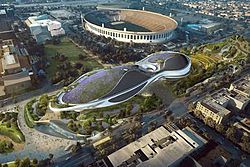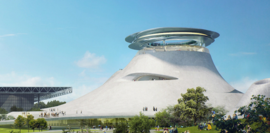Lucas Museum of Narrative Art facts for kids
 |
|

An architectural rendering of the planned museum in Exposition Park, Los Angeles, California.
|
|
| Established | 2026 |
|---|---|
| Location | Exposition Park, Los Angeles, California, United States |
| Type | Art museum |
| Founder | |
| Public transit access | |
The Lucas Museum of Narrative Art is a new museum started by famous filmmaker George Lucas and his wife, businesswoman Mellody Hobson. This museum will show many different kinds of visual storytelling. This includes paintings, photos, sculptures, comic art, and videos. It is currently being built in Exposition Park in Los Angeles, California. The museum is expected to open in 2026.
Contents
What You'll See: The Collections
The Lucas Museum will display art from many talented artists. Some of these artists include Judy Baca, N.C. Wyeth, Carrie Mae Weems, Diego Rivera, and Norman Rockwell. Other artists whose work will be featured are Frank Frazetta, Ralph McQuarrie, Jacob Lawrence, and Jack Kirby.
Important Artworks and Archives
In 2021, the museum announced it had acquired materials related to Judy Baca's huge mural. This mural is called The History of California, also known as the Great Wall of Los Angeles. It is half a mile long and located in the San Fernando Valley.
The museum also acquired a painting by Robert Colescott. It is titled George Washington Carver Crossing the Delaware River: Page from an American History Textbook. The museum's director, Sandra Jackson-Dumont, said this painting connects popular culture and history. She believes it helps the museum show a wider range of art.
In 2019, the museum got the Separate Cinema Archive. This is a large collection of items about African American cinema. It includes movie posters, film photos, scripts, and other historical items. The archive covers the history of these films from 1904 to today. It has about 37,000 objects in total. Stars like Dorothy Dandridge, Paul Robeson, and Sidney Poitier are featured in this collection. The museum believes this archive will help people learn about African American stories told through film.
How the Museum Started: Its History
The first president of the museum was Don Bacigalupi. He used to be the president of the Crystal Bridges Museum of American Art. He left this role in early 2019. In October 2019, Sandra Jackson-Dumont became the new director and CEO.
Where the Museum Almost Was
The museum was first planned for San Francisco. It was going to be called the Lucas Cultural Arts Museum. This version would have held George Lucas's art collection, which is worth a lot of money. After four years of talks that didn't work out, Lucas decided to look for another city.
Chicago was chosen next because its mayor, Rahm Emanuel, was very interested. The city offered land near Lake Michigan for only $1 a year. Los Angeles Mayor Eric Garcetti also offered land in Exposition Park. However, Lucas initially preferred Chicago.
In Chicago, the chosen spot was a parking lot near Soldier Field. This location faced strong opposition. A group called Friends of the Parks opposed the plan. They argued that the land was public and should not be used for a private museum. They even filed a lawsuit to stop the construction.
The design for the Chicago museum was created by MAD Architects. Some people thought the building was too big and would harm the lakefront. Despite changes to the design, the legal challenges continued.
On May 3, 2016, Mellody Hobson announced that they were looking for other cities. This was because of the ongoing issues with Friends of the Parks. On June 24, 2016, George Lucas confirmed that the museum would not be built in Chicago.
Finding a Home in Los Angeles
After the plans in San Francisco and Chicago didn't work out, museum officials considered Los Angeles in June 2016. On January 10, 2017, George Lucas announced that the museum would be built in Exposition Park in Los Angeles. He chose this spot because it is close to the University of Southern California, where he went to college. It is also near other museums and schools.
The building was designed by Ma Yansong from MAD Architects. The museum will be nearly 300,000 square feet and have five levels. It will include 100,000 square feet of gallery space, a library, and learning studios. There will also be two theaters, a restaurant, a café, and an event space. The museum will be surrounded by 11 acres of new park space.
Building the Museum
Construction preparations began in January 2018. The official groundbreaking ceremony happened on March 14, 2018. The museum was first planned to open in 2021. However, due to delays, including those from the COVID-19 pandemic, the opening date was moved. It was first pushed to 2023, then to 2025, and finally to 2026.



